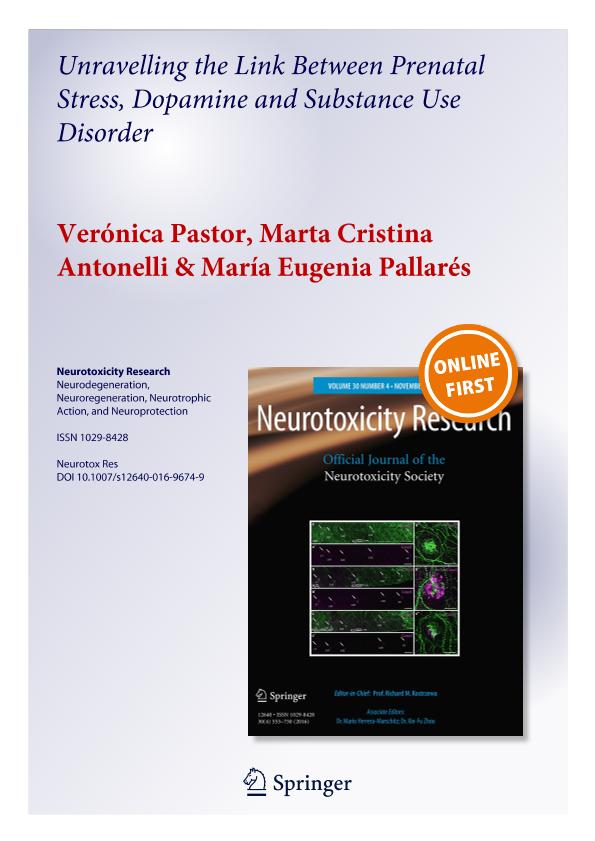Mostrar el registro sencillo del ítem
dc.contributor.author
Pastor, Verónica

dc.contributor.author
Antonelli, Marta Cristina

dc.contributor.author
Pallares, Maria Eugenia

dc.date.available
2018-06-01T19:51:12Z
dc.date.issued
2016-10
dc.identifier.citation
Pastor, Verónica; Antonelli, Marta Cristina; Pallares, Maria Eugenia; Unravelling the Link Between Prenatal Stress, Dopamine and Substance Use Disorder; Springer; Neurotoxicity Research; 31; 1; 10-2016; 169-186
dc.identifier.issn
1029-8428
dc.identifier.uri
http://hdl.handle.net/11336/47028
dc.description.abstract
Substance use disorder (SUD) refers to the detrimental use of psychoactive substances and it is related to a cluster of behavioural, cognitive and physiological dysfunctions indicating that the individual continues using the substance despite significant substance-related problems. Although it is one of the most prevalent neuropsychiatric diseases affecting society worldwide, the mechanism underlying the vulnerability of certain individuals is not well understood yet. It is now widely accepted that, in addition to genetic factors, environmental adversities during critical stages of development of an organism could also be considered as risk factors that contribute to SUD. It has been suggested that prenatal stress (PS) could play an important role in the causal mechanisms of SUD, since it was shown that PS leads individuals to poor stress management and behavioural problems, both of which increase the risk of SUD. It is widely accepted that gestational stress exposure in rats interferes with the correct progeny development. In particular, research in this field points out that the development of the mesocorticolimbic dopaminergic (DA) system is sensitive to disruption by exposure to early stressors. Interestingly, PS induces behavioural abnormalities that are similar to those observed in individuals that present SUD. Since dysfunction of mesocorticolimbic DA pathway has been reported in both prenatally stressed and SUD individuals, in this review we will summarise the current knowledge supporting that PS may serve as a strong candidate to explain the vulnerability of certain individuals to develop SUD following repeated drug exposure. We will also propose a mechanistic hypothesis to explain PS-induced changes on mesocorticolimbic DA system.
dc.format
application/pdf
dc.language.iso
eng
dc.publisher
Springer

dc.rights
info:eu-repo/semantics/openAccess
dc.rights.uri
https://creativecommons.org/licenses/by-nc-sa/2.5/ar/
dc.subject
Foetal Programming
dc.subject
Prenatal Stress
dc.subject
Substance Use Disorder Vulnerability
dc.subject
Mesocorticolimbic Dopaminergic System
dc.subject.classification
Neurociencias

dc.subject.classification
Medicina Básica

dc.subject.classification
CIENCIAS MÉDICAS Y DE LA SALUD

dc.title
Unravelling the Link Between Prenatal Stress, Dopamine and Substance Use Disorder
dc.type
info:eu-repo/semantics/article
dc.type
info:ar-repo/semantics/artículo
dc.type
info:eu-repo/semantics/publishedVersion
dc.date.updated
2018-06-01T19:20:44Z
dc.journal.volume
31
dc.journal.number
1
dc.journal.pagination
169-186
dc.journal.pais
Alemania

dc.journal.ciudad
Berlin
dc.description.fil
Fil: Pastor, Verónica. Consejo Nacional de Investigaciones Científicas y Técnicas. Oficina de Coordinación Administrativa Houssay. Instituto de Biología Celular y Neurociencia "Prof. Eduardo de Robertis". Universidad de Buenos Aires. Facultad de Medicina. Instituto de Biología Celular y Neurociencia; Argentina
dc.description.fil
Fil: Antonelli, Marta Cristina. Consejo Nacional de Investigaciones Científicas y Técnicas. Oficina de Coordinación Administrativa Houssay. Instituto de Biología Celular y Neurociencia "Prof. Eduardo de Robertis". Universidad de Buenos Aires. Facultad de Medicina. Instituto de Biología Celular y Neurociencia; Argentina
dc.description.fil
Fil: Pallares, Maria Eugenia. Consejo Nacional de Investigaciones Científicas y Técnicas. Oficina de Coordinación Administrativa Houssay. Instituto de Biología Celular y Neurociencia "Prof. Eduardo de Robertis". Universidad de Buenos Aires. Facultad de Medicina. Instituto de Biología Celular y Neurociencia; Argentina
dc.journal.title
Neurotoxicity Research

dc.relation.alternativeid
info:eu-repo/semantics/altIdentifier/doi/https://dx.doi.org/10.1007/s12640-016-9674-9
dc.relation.alternativeid
info:eu-repo/semantics/altIdentifier/url/https://link.springer.com/article/10.1007%2Fs12640-016-9674-9
Archivos asociados
